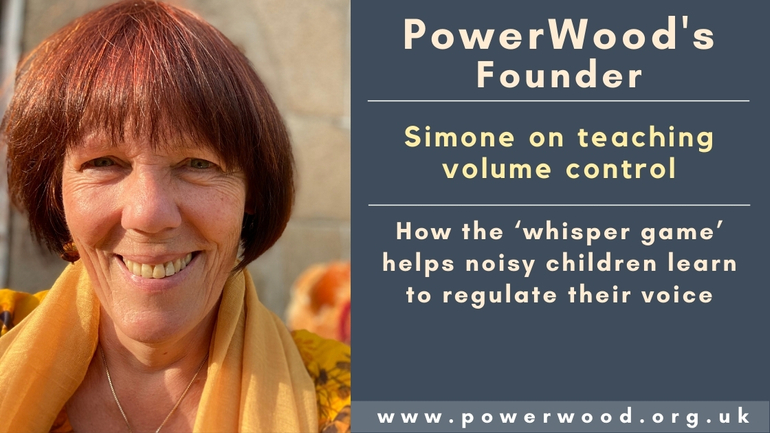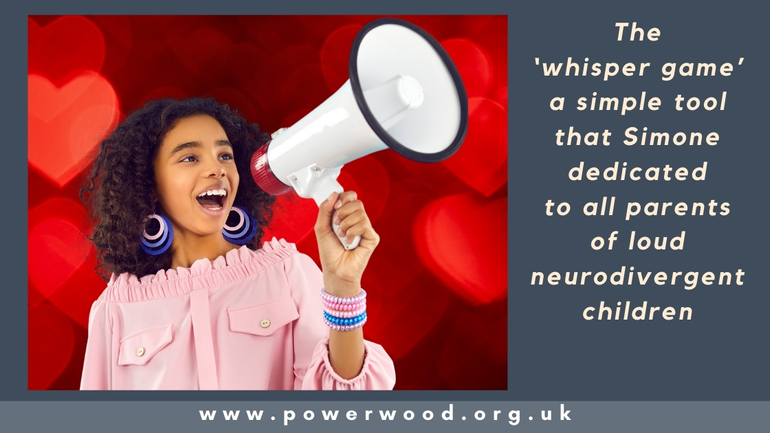
This post includes the ‘biggest gift’ we can give our children and the ‘whisper game’, a tool to help noisy children learn to regulate their voice, which are both part of the Multifaceted Emotion Regulation Theory (MERT) developed by Simone de Hoogh.
Often our children are loud and have difficulty controlling their vocal output.
In such situations, it is helpful to play the whisper game to make our children aware by experience of where their volume control is, the more senses we are able to involve, the quicker the learning happens.
Learning to whisper
We parents can get irritated by the disproportionate noise that our children can make, especially at those times when the expression of their emotions becomes a bit extreme .
A helpful thought is to realise that our children haven’t found the volume control of their voice yet, and it might take a few years before they are able to – and that is where we can help them.
We also want to avoid them learning they can use being loud (or even scream) to annoy others when they feel uncomfortable. This is something they may be doing to get a false sense of safety to mitigate their anxiety, through being in charge of the emotional reactions of others. (Read more about the Cycle of emotional and Sensory Overload to understand this mechanism) This lack of volume control can better be addressed by the ‘Ooh Sweety’ Tool, which is used to strengthen their energy level and emotional resilience while at the same time preventing a further build up of tension.
However, if our child is just loud, the whisper game can be a handy tool to help our children become aware of how to be in charge of their vocal output, as awareness is the first step towards any change.
From singing to whispering
Often children love singing, especially if it takes a playful turn.
We start with singing songs, but going from as loud as we can to the quietest whisper we can manage.
We might want to add big movements with the loud singing, and change our movements towards tiny, slow-motion actions with the whispering, for example, stamping with our feet when we sing loud and tapping very softly with one finger when singing very quietly. We can make our body big and spread our arms and legs when singing loud, making ourselves small when whispering.
From shouting to whispering
We whisper, “Let’s do the whisper game – how softly can you whisper so that I can still hear you?”. We can vary our own level of vocal output as a reaction to theirs to help them become aware of their own output by letting them experience ours as a contrast, for example when they shout we can either react by whispering or even shout louder and ask when whispering. “Can you whisper as softly as I can?”, “Can you still hear me?” “What did I say?” “Can you go even softer, but so that I can still hear what you say?”. If they shout we can shout louder, and we can ask our child to even shout louder, then we can ask if they could still hear us clearly when we were shouting or if the shouting distracted them, and if it hurt their throat or ears.
Just keep on doing the whisper game for short periods of time so it stays fun.
After a while when, for example, you are in the supermarket and your child is shouting loudly you can whisper in response, “Let’s do the whisper game”, and your child will probably follow your lead.
In a situation where you are wanting to apply the tool, check your own emotional resilience first. Are you feeling calm, or are you stressed and likely to become triggered? It’s a good idea to have a contingency plan for if you are having an emotional reaction.
Try to let go of any expectation concerning your child’s behaviour, whether visiting someone, or in the supermarket or whatever social situation. When we are upset it can trigger our child’s emotional block, then whatever tool we apply won’t work. Our goal is not to control them now, our goal is to give them strategies and tools to be able later in life to independently regulate emotions to such an extent that they don’t get in the way of fulfilling their potential.
If our children get used to changing their vocal output from loud to very quiet, we can remind them where to find their volume control.
To raise our child’s awareness of their sound output we can add bodily awareness as discussed above. We can make tiny fluttering movements with our fingers around whispering, growing into including wrists and our hands and finally including our arms as our output gets louder.
If our child shouts loudly in the supermarket because they are feeling upset it might help them to calm down by using these movements. Besides using our kind voice with a smile on our face, we can now also use our actions to signal to the child to whisper. If the movement is connected in their brain with whispering, it will help them to follow our lead and calm down.

Noise can cause an emotional response
People with sensual overexciteability (OE) are “hardwired to produce an “excessive” emotional response”, and that can often include to noises.
This article Misophonia: Scientists crack why eating sounds can make people angry shows that science has proved what was previously dismissed by many. For many people an emotional reaction to noise gets worse when tired, worried or hormonal. If we are easily triggered by noise, it is important to keep our emotional baseline up so we are able to be in charge of the sensory distractions that may be keeping us from being able to act in line with our long-term aims..
Research: The Brain Basis for Misophonia: Current Biology
To protect from noise
Wearing noise-cancelling headphones can be a good way of protecting ourselves or our child from being overwhelmed by an emotional reaction to noise.
Reduce sound stimuli
Those who do not want to listen to music, but do want to enjoy more peace and quiet, can opt for an analogue sound reduction from Loop, earplugs designed to reduce sound stimuli. They have different sound levels, the Experience blocks about 18 decibels (dB), while the Quiet reduces ambient noise by 27 dB. If you want to join conversations, Engage might be the best choice as they state “… allow you to have conversations freely, offering up to 16 dB noise reduction without compromising sound clarity”.
Researching noise-cancelling headphones will allow you to find the one that suits the features you need best and fall within your budget.
We are the best person we can be, and it’s good enough
We all have a gap between who we are and who we would like to be, this gap causes a lot of negative emotions, shame and guilt, self-criticism, self-loathing, disappointments in self etc. All those feelings are the energy that we can use for either an unhelpful train of thought, which is normally about ourselves and not helpful, or for a tiny tiny step towards our personality ideal, acknowledging that it’s all about our journey, and that when we are moving upwards our personality ideal is moving upwards too, so we’ll never get there: it’s all about the journey.
We are all doing the best we can in challenging times, I have never ever met someone purposely intentionally trying to be worse than they are, nor have I ever observed this behaviour in myself or others. We are the best person we can be and it’s good enough.
And let’s remember… to be kind to ourselves too
Sometimes we are struggling to stay calm in the midst of high levels of noise, we might have sensual overexcitability, or we are just tired, worried or upset. If that is the case, let’s remind ourselves that we don’t have to be perfect – ‘good enough’ parenting is good enough. This study finds parents and caregivers need only ‘get it right’ 50 percent of the time.
We can practise the 4-7-8 breathing technique alarm to support ourselves and only use the whisper game tool if we are feeling emotionally resilient and can remain playful. See The Value of our Emotional Independence – PowerWood to read about your emotional baseline.
Life throws us curve balls
It can also be difficult for us parents to accept that we are not always able to live up to our ideals, especially if we have had a challenging childhood. Often our children have challenges that are not well supported outside of our home, which can make us feel isolated, or we are struggling with our (mental) health, relationship challenges, or with finances, etc. All of which may make us feel powerless at times, and less able to create the happy and easy life for our children and ourselves that we would love to.
Grant me the serenity
Over the years I found helpful to ask the following: Grant me the serenity to accept the things I cannot change, the courage to change the things I can, and the wisdom to know the difference.
(Read on below the picture)

Picture by Abigail Cole of PowerWoods Creative Corner:
It’s helpful to be aware that nobody and nothing is ever perfect, and this in itself has its value, because there is always something to improve, something to strive for. Being perfectly imperfect allows us to model to our children that we are able, when we have the energy and emotional resilience (baseline), to put effort into changing ourselves tiny step by tiny step or able to creatively explore a not helpful situation to see if we can find tiny steps to change.
Everything we model to our children reaches them through a process of unconscious assimilation of ideas, knowledge. This just happens gradually and without any obvious effort and is the ideal route for transferring our own norms and values.
The biggest gift
This way also allows us to give our children the biggest gift in life, the ability to change ourselves and our environment. We can model that we are able to make a tiny change through raising awareness and following it through, despite our uncomfortable feelings, modelling feeling comfortable with uncomfortable feelings, showing perseverance, determination and purpose while being accepting of our imperfection, and demonstrating it is good enough to make the effort to change. Through this process our children will acquire this hugely valuable ability too. They will have the ability to take away from their upbringing what they value, and change what they don’t appreciate – and if as adults they are able to do that, then our good enough, imperfect parenting will have done us and them proud.
©2024 Simone de Hoogh, senior coach and educational and parenting consultant, and founder of PowerWood. All posts by Simone de Hoogh
What PowerWood offers
Explore PowerWood and uncover the myriad opportunities it presents for you. Learn how you can become part of our vibrant community and contribute to our mission of supporting families and (young) individuals living with neurodivergence. Join us in our journey to provide support and empowerment, from the perspective that neurodiversity is a positive force for change in society. Discover PowerWood
